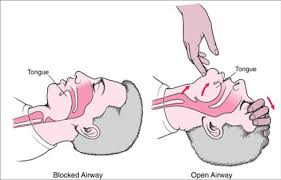A patient suspected of having a severe medication reaction goes into shock. Which of the following first aid measures should the phlebotomist take?
Keep the patient as upright as possible.
Provide a cooling blanket.
Administer oral fluids.
Maintain an open airway.
The Correct Answer is D
Choice A Reason:
Keeping the patient as upright as possible is not recommended in cases of shock. When a patient is in shock, it is important to lay them down and elevate their legs slightly, unless this position causes pain or further injury. This position helps improve blood flow to the brain.
Choice B Reason:
Providing a cooling blanket is not a standard first aid measure for shock due to a medication reaction. A cooling blanket may be used in cases of hyperthermia or heatstroke to reduce body temperature, but not typically for shock, which requires maintaining normal body temperature and preventing chilling.
Choice C Reason:
Administering oral fluids to a patient in shock is not advisable. During shock, a patient may have an impaired swallowing reflex or be unconscious, increasing the risk of aspiration. It is best to avoid giving anything by mouth until medical personnel arrive.
Choice D Reason:
Maintaining an open airway is crucial for a patient in shock. Ensuring that the airway is clear allows the patient to breathe effectively, which is essential for delivering oxygen to the tissues and organs. If the patient is unconscious or has an altered level of consciousness, the phlebotomist should check for breathing and begin CPR if necessary.

Nursing Test Bank
Naxlex Comprehensive Predictor Exams
Related Questions
Correct Answer is A
Explanation
Choice A Reason:
Explaining the procedure to both the parent and the child is crucial. It helps in preparing the child psychologically and ensures that the parent is informed and can provide support during the process. Clear communication can reduce anxiety and make the child more cooperative. It is also a part of informed consent, where the parent understands what the procedure entails and why it is necessary¹².
Choice B Reason:
Choosing not to tell the child when the needle insertion is coming might seem like a way to avoid causing them anticipatory anxiety. However, this approach can lead to mistrust. Children need to be prepared for what to expect, and surprising them can be more traumatic in the long run. It is better to be honest and use age-appropriate language to describe the sensation as a 'quick pinch' or 'poke'¹².
Choice C Reason:
Obtaining a heel stick is a common method for blood collection in infants, particularly newborns, as their veins are not as developed. However, for preschoolers, venipuncture is usually the preferred method because they have more developed veins, and it allows for a larger volume of blood to be collected if needed³.
Choice D Reason:
Obtaining a thumb stick is not a standard practice for blood collection in preschoolers. The thumb has bones and tendons close to the surface, which can increase the risk of injury. The preferred sites are the antecubital fossa of the arm or the back of the hand where the veins are more accessible and there is less risk of hitting bone³.
Correct Answer is B
Explanation
Choice A Reason:
The timeline of the individual prior to specimen collection is important for context but is not typically part of the chain of custody documentation. The chain of custody focuses on the handling of the specimen rather than the activities of the individual before the collection.
Choice B Reason:
The identity of each person who handles the specimen is a critical element of the chain of custody. This information ensures that the specimen can be tracked at every stage from collection to analysis, and any potential tampering can be identified and addressed.
Choice C Reason:
While the physical and mental status of the individual may be noted in medical records or police reports, it is not a standard part of the chain of custody for a blood alcohol test. The chain of custody's purpose is to track the specimen, not the condition of the individual.
Choice D Reason:
The condition of the specimen every hour is not required in the chain of custody documentation. What is necessary is the documentation of any changes in the condition of the specimen that could affect the integrity of the results, such as temperature excursions or signs of tampering.
Whether you are a student looking to ace your exams or a practicing nurse seeking to enhance your expertise , our nursing education contents will empower you with the confidence and competence to make a difference in the lives of patients and become a respected leader in the healthcare field.
Visit Naxlex, invest in your future and unlock endless possibilities with our unparalleled nursing education contents today
Report Wrong Answer on the Current Question
Do you disagree with the answer? If yes, what is your expected answer? Explain.
Kindly be descriptive with the issue you are facing.
